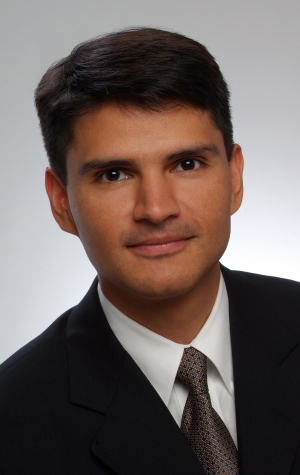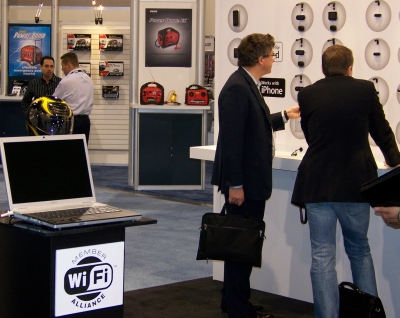It has been several months since I had the chance to speak to Edgar Figueroa of the Wi-Fi Alliance. To establish the timeframe, he and I talked one or two days before Michael Crabtree of Texas Tech made that highlight reel, last-minute catch and scored to upset the then #1 ranked Texas Longhorns in football. Those are significant details, because Edgar is a product of the University of Texas, and I went to Tech. It was a big week, but not too big to discuss our common passion – Wi-Fi.

Edgar Figueroa, Wi-Fi Alliance
And of course, I have just now come down from the high of a Tech victory so that I can recall the conversation.
Meanwhile, Figueroa and friends at the Wi-Fi Alliance continue their winning ways. Last month they announced sales of Wi-Fi chipsets for 2008 rose 26 percent to 387 million units, according to InStat and the Wi-Fi Alliance. (Ha, this news should also bode well for a blog that’s main focus is Wi-Fi …)
While a large percentage of those numbers may represents the chips in the laptops I burn up, here are the actual breakdowns:
- 56 million cell phones, up 52 percent
- 48 million consumer electronics units (TVs, game consoles, etc.), up 51 percent
- 71 million handhelds (games, cameras, music players), up 33 percent
- 144 million PCs, (or other mobile computing devices), up 23 percent
And the Alliance expects continued success throughout 2009. Why shouldn’t they, with a president who purportedly knows how to use a Blackberry.
So Edgar, what makes Wi-Fi so cool?
In a phone interview, he explained that the key to Wi-Fi success is the interoperability – not just that Wi-Fi enabled devices work together, but that they do so with optimal, secure performance. The Alliance performs constant compatibility testing.
“You may see good performance and things may connect together, but if you don’t have the right security, eventually, you know you’ll have a bad experience,” Figueroa said. “So, we think we have a unique recipe with the program that end users continue to put a lot of faith in.”
The Alliance also benchmarks and takes the market’s pulse to see how the Wi-Fi Certified brand is regarded. Just how important is the brand?
“I can tell you for sure that if you don’t have Wi-Fi certification that your competitors will use it against you,” said Dorothy Stanley of Aruba, the mobility networking giant.

Dorothy Stanley, Aruba
“There are a couple of different perspectives. From our Aruba internal perspective, Wi-Fi certification is essentially ‘a bar.’ It is a level that we have to meet and one our customers expect us to meet. It gives them a confidence that there will be a level of interoperability between the infrastructure they deploy and the client devices.”
Stanley said customers may deploy two vendors’ equipment for infrastructure across a large enterprise, in multiple locations. But there could be dozens of vendors providing scanners, RFID tags, and a litany of Wi-Fi enabled devices.
“So they’re looking for the Wi-Fi certification to be not only on the infrastructure side – where they’re putting their Aruba gear – but they also want Wi-Fi certification on the client devices that are coming in,” she said.
See: Aruba news release
Figueroa shared research showing that in the U.S. and the UK more that 75 percent of end users know the Wi-Fi certified logo, and in the various areas that polled around the world, most buyers are willing to pay 10 percent more on products that are Wi-Fi certified.
Remember the old music television ad: “I want my MTV”? It seems these days college kids lust for Wi-Fi, with one survey claiming that Wi-Fi was more important than beer and/or mother’s milk.

Representin at CES, Las Vegas
“You know the times they are a changing right,” he said. “Some of the nuggets were that 9 out of 10 of them say that Wi-Fi access is essential to education today in classrooms. And 79 percent said that without Wi-Fi, college would be a lot harder … 72 percent said they would rather wear their rival schools team colors rather than give up Wi-Fi.” (Or maybe they just lost a bet …)
So, no doubt, Wi-Fi certification is like the “Good Housekeeping Seal of Approval” or the maybe the “Intel Inside” brand that consumers and companies demand. But what new technologies are driving the growth?
The Alliance has certified more than 5,000 products. Figueroa said he expects more than 50 percent of new Wi-Fi certified equipment will be 802.11n Wi-Fi gear. In a nutshell, the 802.11n standard adds technology and tweaks existing technologies to give Wi-Fi more speed and range. The most notable new technology is called multiple input, multiple output (MIMO).
Then there is WiMAX to contend with – which many baseball fans describe as Wi-Fi “on steroids.”
“We put Wi-Fi in 500 million products (units) accessible to anyone, anywhere,” Figueroa said. “So you’re looking at a license spectrum that’s homologated around the world, it’s just that diversity that’s par with about any connectivity technology. The new technologies are similar in that they provide connectivity. They’re different in terms of benefits, and what specific connectivity they provide. So we view one as sort of the wide area network connectivity technology (WiMAX) and the other one (Wi-Fi) brings connectivity to their fingertips.”
So, can I put a Wi-Fi toaster on my groom’s registry at Lowe’s?
“Oh you know I could talk about this for days. We’ve certified a backhoe,” Figueroa said. “There’s quite a range of products . . . we certified an access point for a submarine. And the thing looked like a coffin.”
There are Wi-Fi saunas, doorknobs and thermostats for the home, although the buyer must beware and look for the Wi-Fi Alliance brand … They are a choosy lot. It is estimated that 25 percent of all new Wi-Fi products presented do not pass on the first attempt. There are testing labs all over the world, with the most recent opening – the second Chinese facility in Shanghai.
“We go where the activity is,” he said. “This lab is in the southern part where it ends up being more convenient to some of our members and some of our future members. But as to whether there will be new activity because we built the lab . . . that’s usually not how our model works.”
Forty-three percent of the Wi-Fi Alliance members are in Asia.
“We tend to go where the emerging markets are and this past year . . . a number of times we were in China, we were in India and we’re seeing several new members from these areas. Another area that is also an area of growth where we are seeing more and more new companies join the Alliance is from operators. Probably a good example of both an emerging area and an area that’s also got some operators joining is Brazil.”
What’s around the corner?
“We’ll be building on some of that approach and some of those mechanisms and metrics in a next generation program that we’ll call the Voice Over Wi-Fi Enterprise,” he said. “So now we are talking about the performance with dozens of concurrent calls with things like fast roaming and network management, … you know very large scale kinds of voice application.”
And the Wi-Fi Alliance members? It’s a who’s who of electronics and networking: Dell, Cisco, HP, TI, Sony, Apple, LinkSys, Palm, Epson, Boingo, Canon, Netgear, Panasonic … and my favorite name, FunkWerk … and way too many to mention.
See for yourself:


